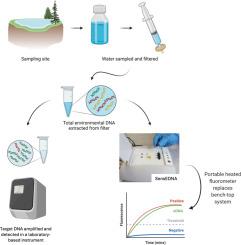SensEDNA: An innovative optical CRISPR platform for rapid environmental DNA monitoring
IF 3.7
Q1 CHEMISTRY, ANALYTICAL
引用次数: 0
Abstract
Biodiversity loss is at an all-time high increasing the need for simple and rapid species monitoring systems. Management and conservation of fish species within aquatic environments requires knowledge of distribution, traditionally gained through visual detection and counting. These methods are expensive, time consuming and can lead to harm of the species of interest. Environmental DNA (eDNA) offers a solution to this through detection of DNA that may be shed into the environment by a given target species. Integrating eDNA based molecular assays to a biosensor device enables onsite sample testing for rapid species assessment.
Herein, a portable fluorometer with incubating capabilities (SensEDNA) was custom designed and built to conduct the simultaneous incubation and fluorescent detection steps required for isothermal eDNA detection. The system features three optical cells to enable triplicate analysis. Each optical cell is set to incubate at 37 °C and control within 0.5 °C. Fluorescence detection with excitation at 485 nm and emission at 535 nm was integrated and optimised to provide highest signal/noise ratio while minimising fluorescence bleaching. The system comprises a simple LED/high pass filter/photodiode configuration and is controlled by a Wixel board. This affordable and user-friendly optical detection platform, coupled with RPA-CRISPR-Cas, provides a crucial step towards on-site single species identification from eDNA.

SensEDNA:一个创新的光学CRISPR平台,用于快速环境DNA监测
生物多样性的丧失正处于空前的高度,增加了对简单和快速物种监测系统的需求。水生环境中鱼类的管理和保护需要有关分布的知识,传统上是通过目测和计数获得的。这些方法成本高,耗时长,而且可能导致对感兴趣的物种的伤害。环境DNA (eDNA)通过检测可能由给定目标物种释放到环境中的DNA提供了解决方案。将基于eDNA的分子分析集成到生物传感器设备中,可以进行现场样品测试,以进行快速物种评估。为此,我们定制了一种具有孵育功能的便携式荧光仪(SensEDNA),用于同时进行等温eDNA检测所需的孵育和荧光检测步骤。该系统具有三个光学单元,可以进行三次重复分析。每个光学细胞设置在37°C孵育,控制在0.5°C内。集成并优化了485 nm激发和535 nm发射的荧光检测,以提供最高的信噪比,同时最大限度地减少荧光漂白。该系统包括一个简单的LED/高通滤波器/光电二极管配置,并由一个Wixel板控制。这种价格合理且用户友好的光学检测平台,加上RPA-CRISPR-Cas,为eDNA的现场单物种鉴定提供了关键的一步。
本文章由计算机程序翻译,如有差异,请以英文原文为准。
求助全文
约1分钟内获得全文
求助全文

 求助内容:
求助内容: 应助结果提醒方式:
应助结果提醒方式:


